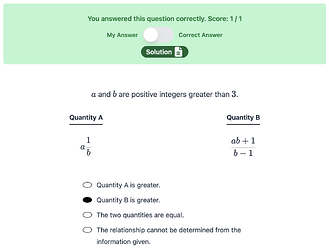After looking at the solution, I realized I got this right by accident. I’d suggest a clarification that a \frac{1}{b} represents a mixed fraction, not a product.
In retrospect, it makes sense given the section I was in. But my expectations took over: a \frac{1}{b} would be a product in almost every other scenario.
Generally, any standard resource would make explicit if it was the product for this exact reason of ambiguity. There’s also the question of why write a \cdot \frac 1b when they could’ve just wrote:
\frac ab, a \cdot \frac 1b, a (\frac 1b), \ldots
1 Like
@cylverixxx Sorry, I can’t tell if you agree that the question requires clarification or not. 
To make sure we’re on the same page, by a \frac{1}{b} the question means the mixed fraction a + \frac{1}{b} = \frac{ab + 1}{b}. (That’s why the second quantity \frac{ab + 1}{b - 1} is easy to compare – just compare the denominators.) This is, I think, an unusual notation that only makes sense inside the section on mixed fractions. So I’m suggesting a small clarification about what Quantity A means.
@Leaderboard Thank you for the reference. I’ll reproduce the relevant part here (emphasis mine):
- Standard mathematical symbols at the high school level are used. These include the standard symbols for the arithmetic operations of addition, subtraction, multiplication, and division (+, -, \times, and \div), though multiplication is usually denoted by juxtaposition, often with parentheses, for example, 2y and (3)(4.5), and division is usually denoted with a horizontal fraction bar, for example, \frac{2}{w}. Sometimes mixed numbers, or mixed fractions, are used, like 4 \frac{3}{8} and -10 \frac{1}{2}. (The mixed number 4 \frac{3}{8} is equal to the fraction \frac{35}{8}, and the mixed number -10 \frac{1}{2} is equal to the fraction \frac{-21}{2}.) Exponents are also used, for example, 2^{10} = 1,024, 10^{-2} = \frac{1}{100}, and x^0 = 1 for all nonzero numbers x.
By my reading, the bold parts support my interpretation. For variables, juxtaposition means multiplication. For numbers and numbers only, juxtaposition may indicate a mixed fraction.
In hindsight it’s clear what this question was going for. And I think it’s a clever question! But if it’d appeared in any other section, it would’ve been interpreted differently. So I’m suggesting a small clarification like “the mixed fraction a \frac{1}{b}” so it’s clear what’s expected.
No i agree with you that it has to could’ve been made more explicit, but if it actually meant multiplication they they could’ve just written \frac ab or any other variation i’ve enumerated above. Anyhow, mixed fractions are generally useless notation lol, so if you found it ambiguous then i don’t blame you.
1 Like
